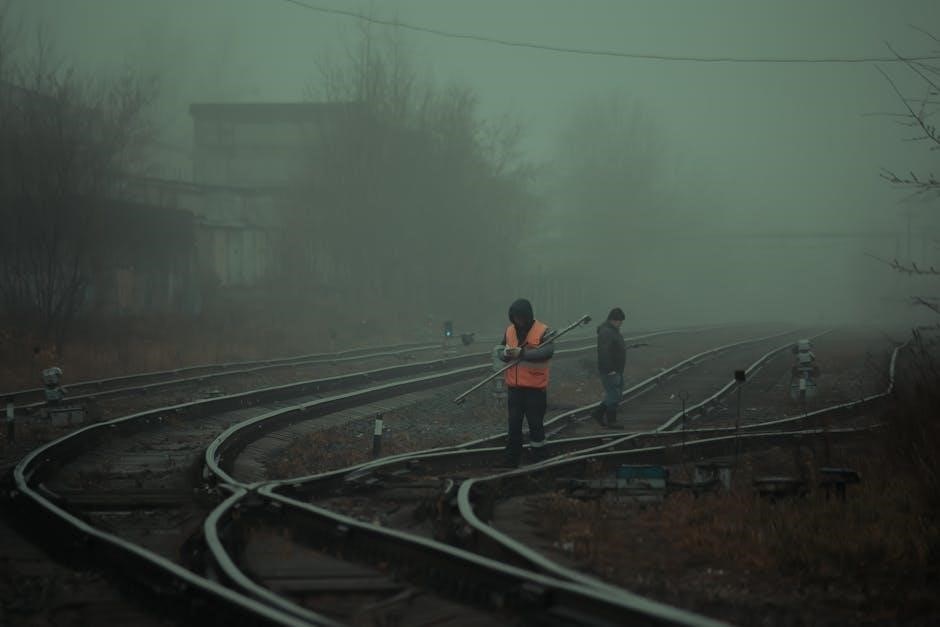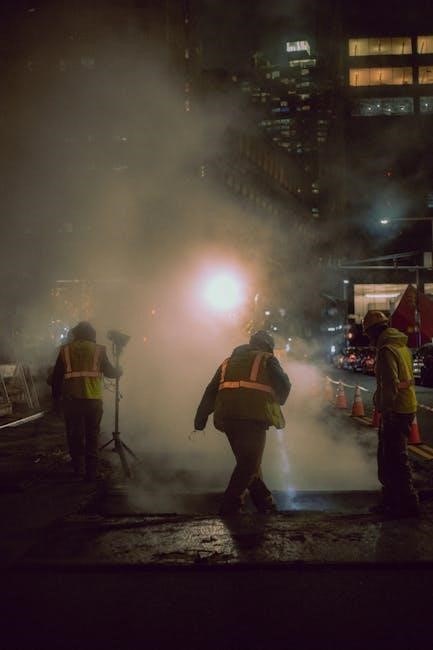The USAR Field Operations Guide (FOG) 2021 is a comprehensive resource developed by FEMA and the U.S. Army Corps of Engineers, providing standardized procedures for urban search and rescue operations. It covers critical topics like structural collapse identification, communication protocols, and marking systems, ensuring teams operate safely and effectively in disaster scenarios.

Overview of the FOG Manual
The USAR Field Operations Guide (FOG) Manual 2021 is a detailed, 314-page resource developed by FEMA’s US&R Structures Sub-group in collaboration with the U.S. Army Corps of Engineers. It serves as a critical reference for urban search and rescue teams, providing standardized procedures, best practices, and technical guidance for responding to disasters. The manual covers a wide range of topics, including search and rescue operations, structural collapse identification, marking systems, and communication protocols. Designed to enhance safety and efficiency, the FOG manual is an essential tool for USAR personnel, ensuring they are equipped to handle complex rescue scenarios effectively.
Importance of the FOG for USAR Teams
The USAR Field Operations Guide (FOG) 2021 is a critical resource for urban search and rescue teams, providing standardized procedures and technical guidance to ensure effective and safe operations. It equips teams with the knowledge to systematically approach search and rescue missions, identify structural hazards, and communicate effectively during emergencies. The manual’s emphasis on interoperability and adherence to established protocols enhances coordination among response personnel. By following the FOG, USAR teams can improve efficiency, reduce risks, and save lives in disaster scenarios. Its comprehensive updates make it an indispensable tool for modern rescue operations, ensuring teams are prepared for the challenges of technical rescues and large-scale incidents.

Key Topics Covered in the USAR FOG Manual 2021
The FOG manual covers search and rescue operations, structural collapse patterns, communication protocols, marking systems, and safety procedures, providing essential guidance for USAR teams in disaster response.
Search and Rescue Operations
The 2021 FOG manual provides detailed guidance on search and rescue operations, emphasizing systematic search methods and the use of specialized tools and technology. It outlines procedures for identifying and marking search areas, ensuring efficient and thorough coverage. The guide also highlights the importance of operational protocols, including the deployment of canine teams and the use of advanced technologies like thermal imaging and acoustic listening devices for victim detection. These methods enhance the accuracy and speed of rescue efforts, particularly in challenging environments such as collapsed structures or debris-filled areas. By adhering to these guidelines, USAR teams can maximize their effectiveness while minimizing risks to both rescuers and survivors. The manual underscores the critical role of teamwork and coordination in achieving successful outcomes during search and rescue missions.
Structural Collapse Patterns and Safety
The 2021 FOG manual emphasizes the importance of understanding structural collapse patterns to ensure the safety and effectiveness of USAR operations. It provides detailed descriptions and visual aids to help teams identify potential hazards, such as unstable structures and hidden voids. Recognizing these patterns is critical for assessing risks and developing safe rescue strategies. The guide outlines methods for evaluating damage and predicting potential failures, enabling teams to operate with greater confidence in unstable environments. By adhering to these guidelines, USAR personnel can minimize risks to themselves and survivors, ensuring more effective and efficient rescue operations in disaster scenarios. This knowledge is essential for navigating complex and dangerous structural conditions.
Structural Collapse Identification and Response
The FOG manual emphasizes the importance of rapid and accurate identification of structural collapses to ensure safe and effective response. It provides detailed methods for assessing damage, recognizing hazards, and stabilizing structures to protect both rescuers and survivors. These techniques are crucial for USAR teams to operate efficiently in dangerous environments. The guide underscores the need for careful planning and execution to mitigate risks during rescue operations. By following these protocols, teams can enhance safety and achieve successful outcomes in disaster scenarios. This section is vital for understanding how to navigate and respond to structural collapses effectively.
Types of Collapses (Pancake, Lean-To, V-Shape, Cantilever)
The 2021 FOG manual details four primary types of structural collapses: pancake, lean-to, V-shape, and cantilever. A pancake collapse occurs when upper floors fall onto lower ones, creating a compressed, layered effect; Lean-to collapses happen when a structure tilts and rests against another building or object. V-shape collapses form a “V” shape, often due to asymmetric loading or weak points in the structure. Cantilever collapses involve a portion of the building protruding without support, such as a balcony or roof overhang. Each type requires unique assessment and response strategies to ensure safety and effective rescue operations. Visual aids in the FOG manual help teams identify these patterns quickly and accurately. Understanding these collapse types is critical for USAR teams to operate safely and effectively in disaster scenarios.

Visual Aids and Descriptions for Identification
The 2021 FOG manual incorporates detailed visual aids, including diagrams and photographs, to help USAR teams identify structural collapse patterns. These visuals are accompanied by descriptive text, outlining key features of pancake, lean-to, V-shape, and cantilever collapses. The guide provides examples of compression points, void spaces, and debris configurations, enabling teams to assess risks accurately. High-quality images and annotated illustrations aid in recognizing critical indicators, such as sagging beams or uneven walls. These resources enhance situational awareness and support decision-making during rescue operations. By referencing these visual aids, responders can quickly diagnose collapse types and implement appropriate safety measures, ensuring efficient and safe operations in disaster scenarios.

Communication and Interoperability in USAR Operations
The 2021 FOG emphasizes radio channel programming for interoperability, ensuring seamless communication among USAR teams during disaster responses, enhancing coordination and operational efficiency.

Radio Channel Programming for Effective Communication

Radio channel programming is crucial for interoperability in USAR operations, as outlined in the 2021 FOG. The manual provides detailed templates and guidelines for configuring interoperability channels, ensuring seamless communication between different agencies and teams. Standardized channel names and frequencies help reduce confusion during emergencies. The guide also covers best practices for system managers to design and program these channels effectively. Proper programming ensures that all team members can communicate without delays, enhancing coordination and response efficiency. This standardized approach is essential for large-scale operations, where multiple organizations may be involved. The 2021 FOG emphasizes adherence to these protocols to maintain clear and reliable communication.
Marking Systems and Procedures
The 2021 FOG details standardized marking systems, such as the FEMA US&R Marking System, to clearly identify searched areas and structural shoring requirements, ensuring operational efficiency and safety.
FEMA US&R Marking System
The FEMA US&R Marking System is a standardized method for marking buildings and structures during search and rescue operations. It ensures clear communication among rescue teams, providing critical information such as the date and time of the search, the team identifier, and the status of the structure. This system helps prevent redundant searches, reduces risks to rescuers, and ensures that all areas are thoroughly checked. The markings are applied in a consistent manner, typically on the front of the building, and are easily visible to other teams. This system is a key component of the FOG manual, emphasizing efficiency and safety in USAR operations.
Shoring Symbols and Their Applications
Shoring symbols are essential tools used by USAR teams to communicate structural stabilization methods effectively. These symbols, detailed in the FOG manual, represent various shoring techniques such as raking shores, flying shores, and horizontal shores. They are applied at incident scenes to indicate the type of shoring used, ensuring clarity and safety for all personnel. The symbols are standardized, allowing for quick recognition and understanding, which is critical in time-sensitive rescue operations. Proper application of shoring symbols ensures that structural integrity is maintained, reducing risks to rescuers and survivors. This system is a key component of the FOG manual, emphasizing clear communication and operational efficiency in technical rescue scenarios.

Updates and Relevance of the 2021 FOG
The 2021 FOG updates include enhanced search techniques, improved safety protocols, and advanced tools, reflecting current best practices and technologies. It remains a crucial resource for USAR teams, ensuring they are equipped with the latest information to respond effectively in evolving disaster scenarios.
New Guidelines for Search and Rescue Techniques
The 2021 FOG introduces updated search and rescue techniques, emphasizing systematic approaches and the use of advanced tools and technologies. These guidelines enhance operational efficiency, ensuring USAR teams can locate and assist victims more effectively. Enhanced protocols for canine teams and advanced victim detection technologies are highlighted, providing teams with robust methods to navigate complex disaster scenarios. Additionally, the manual underscores the importance of adhering to operational protocols to ensure safety and maximize rescue efforts. These updates reflect the evolving nature of disaster response, equipping teams with the latest strategies to save lives efficiently.


The USAR Field Operations Guide (FOG) 2021 is a vital resource for modern disaster response, equipping teams with updated techniques and protocols to save lives effectively.
The Role of the FOG in Modern USAR Missions
The USAR Field Operations Guide (FOG) 2021 plays a pivotal role in modern urban search and rescue missions by providing standardized procedures and updated techniques. It ensures that USAR teams operate safely, efficiently, and effectively in complex disaster scenarios. The guide covers critical areas such as search and rescue operations, structural collapse identification, communication protocols, and marking systems. Developed collaboratively by FEMA and the U.S. Army Corps of Engineers, the FOG serves as a cornerstone for training and mission execution. Its emphasis on structural assessment, interoperability, and shoring symbols enhances situational awareness and decision-making. By adhering to the FOG, USAR teams can better navigate challenging environments, prioritize victim safety, and achieve successful mission outcomes in today’s dynamic emergency response landscape.

